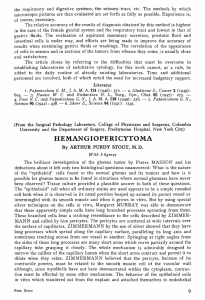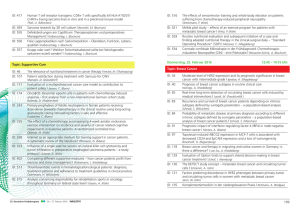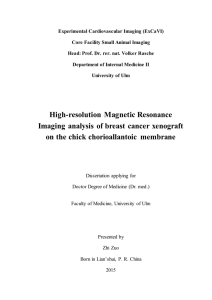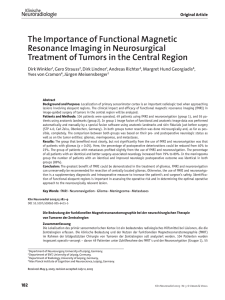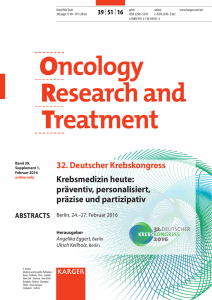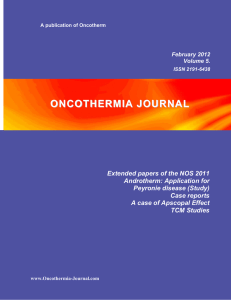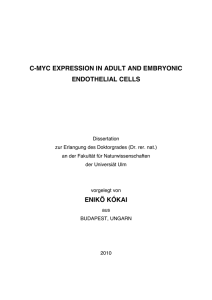Read the Research - Timeless Health Clinic
Werbung
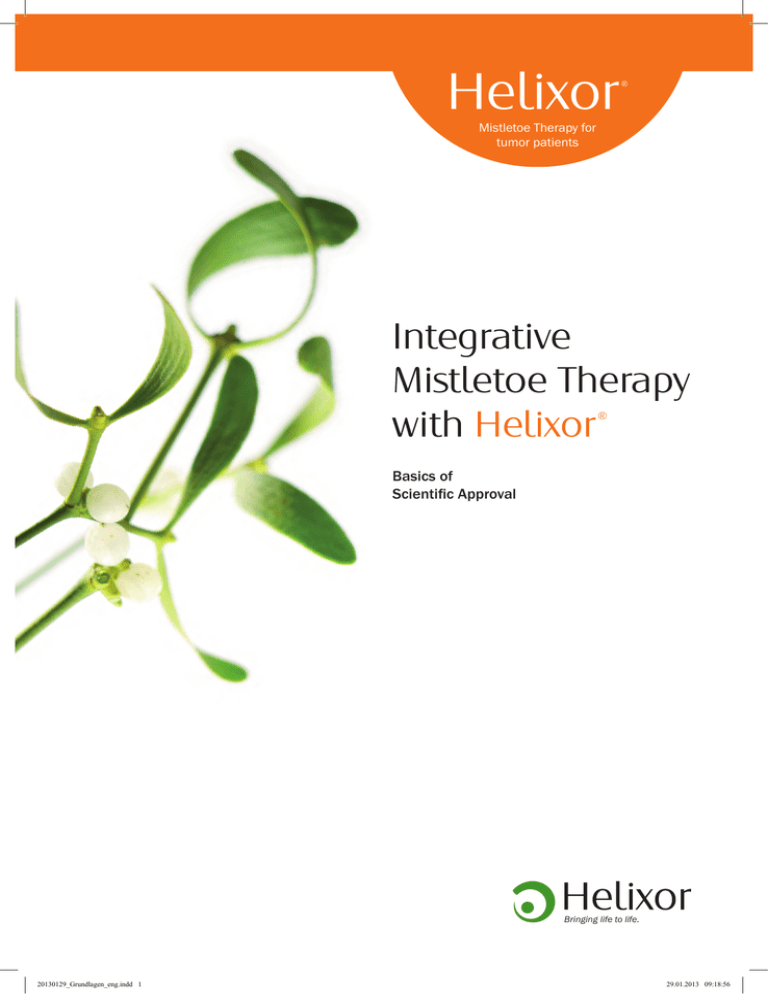
Helixor ® Mistletoe Therapy for tumor patients Integrative Mistletoe Therapy with Helixor ® Basics of Scientific Approval Bringing life to life. 20130129_Grundlagen_eng.indd 1 29.01.2013 09:18:56 20130129_Grundlagen_eng.indd 2 29.01.2013 09:18:56 Helixor® mistletoe products are pure, sterile filtered, aqueous fresh plant extracts of Viscum album L. (white-berried mistletoe). Standardized production processes as well as continuous physical, chemical and biological quality control (including assessment of cytotoxic effects on MOLT 4 leukemia cells to determine the biological activity of the mistletoe product) guarantee a consistent batch-to-batch quality. 3 20130129_Grundlagen_eng.indd 3 29.01.2013 09:19:03 Pharmacological Effects Pharmacological effects of Helixor® have been described in more than 120 scientific publications and are mainly based on: • Immunomodulation: activation of macrophages, dendritic cells and natural killer cells, enhancement of phagocytosis as well as increase of eosinophils, lymphocytes and T-helper cells. • DNA protective effects on peripheral immune cells, protection from immunosuppressive effects of chemotherapy. In addition, it was possible to show dose-dependent cytotoxicity in tumor cell lines through apoptosis induction as well as inhibition of tumors and metastases in animal experiments. There are also first indications of inhibition of tumor angiogenesis. A summary of these research results can be found in “Komplementäre Tumortherapie mit Mistelextrakten – eine aktuelle Übersicht.“ (Schierholz JM, Schlodder D.) (approx. transl. of title: “Complementary tumor therapy with mistletoe extracts – a current overview”) (25). Registration and Marketing Authorization After several years of clinical testing Helixor® products were registered in Germany in 1976 according to German drug legislation (Arzneimittelgesetz, AMG), followed by marketing authorization in February 1982. Thus it was the first mistletoe product to be authorized for subcutaneous injection in Germany. Helixor® mistletoe products have been authorized or registered in Austria, Switzerland, Luxembourg, Sweden, Finland, Latvia, Lithuania, Korea, China, Russia, Chile, Peru and Canada. 4 20130129_Grundlagen_eng.indd 4 29.01.2013 09:19:03 Studies Efficacy and safety of Helixor® was shown in a positive monograph published by the Commission C of the German Department of Public Health (19), in 24 clinical studies (1 - 11, 20 - 24, 26, 28 - 33, 36) as well as in numerous case reports. Two further studies have been conducted on off-label use (18, 34). Clinical Studies with Helixor® Summary of all studies involving Helixor® Total Studies: Patients (without control groups): Methodology Indication* Parameters* Results 5,796 Prospective randomized: 8 Prospective non-randomized: 4 Retrospective: Tumor type 26 14 Breast: 8 Colorectal: 6 Others: 3 Several entities: 9 Palliative therapy in inoperable/ metastasizing tumors: 17 Prevention of relapse: 17 Survival: 16 Quality of life: 11 Reduced side effects of oncological therapies: 7 Immune parameters: 4 Response rate: 5 Relapse rate: 1 Advantage with Helixor® compared to controls: 21 Significant advantage: 15 Trend: 6 No advantage: 2 Single-arm cohort studies with significant improvement: 2 *Multiple references possible 5 20130129_Grundlagen_eng.indd 5 29.01.2013 09:19:04 The most recent and highest-quality studies give evidence of improved quality of life and better tolerability of chemotherapy during concomitant supportive therapy with Helixor® products. As a recent study showed, there are no indications of these effects being based on negative influences on conventional standard oncological therapy. • The two-part monocentric phase I dose escalation study was conducted in the USA under the auspices of the National Center for Complementary and Alternative Medicine (NCCAM) and in collaboration with the National Cancer Institute (NCI). It investigated in particular possible interactions between cytostatics and herbal medicinal products using the combination of Helixor® A and gemcitabine as a specific example. The latter administered especially in palliative chemotherapy of far advanced solid tumors. The aim of the study was to determine the maximum tolerated doses and to investigate potential drug-drug interaction. The study included a total of 44 patients with far advanced solid tumors (pancreas, NSCLC, breast, colorectal). During part I of the study the patients were given a constant gemcitabine dose of 750 mg/m2 on days 1 and 8 of the three-week cycle, while the Helixor® A dose was gradually increased. Dose escalation in five steps including 3 patients per step (drop-outs were replaced) showed that the aimed for daily dose of 250 mg was tolerated without any problems. During part II of the study all patients received a daily dose of 250 mg Helixor® A while the gemcitabine dose was increased in a dose escalation program of six 20 % steps with an initial dose of 900 mg /m2. At a concentration level of 1560 mg /m2 there were 3 cases of dose-limiting toxicity, so that the maximum tolerated gemcitabine dose was 1300 mg /m2 (an increase of 30 % compared to gemcitabine monotherapy). Enabling higher dosage of gemcitabine during chemotherapy of tumor patients through welltolerated concomitant therapy with Helixor® A. Part I Dose escalation of Helixor® A Number of patients: n = 20 MTD Mistletoe dose step 5: 250 mg/day Mistletoe dose step 4: 200 mg/day Mistletoe dose step 3: 100 mg/day Mistletoe dose step 2: 50 mg/day Mistletoe dose step 1: 20 mg/day 5 Pat. 6 Pat. 3 Pat. 3 Pat. 3 Pat. Gemcitabine: fixed dose 750 mg/m2 on day 1 and 8 of the three-week cycle. MTD: maximum tolerated dose 6 20130129_Grundlagen_eng.indd 6 29.01.2013 09:19:04 Part II Dose escalation of Gemcitabine Number of patients: n = 24 Gemcitabine step 11: 2246 mg/m2 Gemcitabine step 10: 1872 mg/m2 3 DLTs MTD 1 DLT 1 DLT Gemcitabine step 9: 1560 mg/m2 Gemcitabine step 8: 1300 mg/m2 Gemcitabine step 7: 1080 mg/m2 Gemcitabine step 6: 900 mg/m2 4 Pat. 6 Pat. 7 Pat. 7 Pat. Helixor® A: fixed dose (250 mg /day) DLT: dose-limiting toxicity, MTD: maximum tolerated dose Pharmacokinetics of gemcitabine were not affected by Helixor® A. The dose-dependent increase of neutrophils during part I of the study and the recorded levels of plasma cytokine concentration point towards immunocompetence being retained. High tolerability of gemcitabine due to concomitant therapy with Helixor® A was not accompanied by a lower efficacy since the observed partial response rate of 6 % corresponds to the usual efficacy of gemcitabine monotherapy in such a patient population. Additionally, stable disease in 42 % of patients is definitely remarkable (21). 7 20130129_Grundlagen_eng.indd 7 29.01.2013 09:19:04 Tolerability of chemotherapy can be improved by using Helixor® A both in palliative and curative situations. Evidence of this was shown in an approval study and in a prospective randomized double-blind study. • During the prospective randomized multicenter approval study of EBM level Ib, 233 patients with breast, ovarian and non-small cell lung cancer were treated with standard polychemotherapy. The verum group received additional Helixor® A, the control group was given the immunostimulant Lentinan (oncological standard supportive medication in China/Japan with proven efficacy on quality of life). The aim of the study was to determine quality of life and tolerability of polychemotherapy. Quality of life was assessed by means of three different validated questionnaires and indices. The influence of mistletoe therapy on tolerability of chemotherapy was investigated by group comparison of adverse events due to side effects of chemotherapy. Use of Helixor® A shows significant improvement of quality of life in comparison to active control group Helixor® A (n = 115) [Scores] 6 KPI increase in % of patients Active control group (n = 109) 50.4 % 32.4 % 3 -1 0 p = 0.0141 FLIC TCM FLIC = Functional Living Index: Cancer TCM = Traditional Chinese Medicine Score KPI = Karnofsky Performance Index p = 0.0007 KPI p = 0.002 8 20130129_Grundlagen_eng.indd 8 29.01.2013 09:19:04 In patients who were additionally treated with Helixor® A, statistics showed significantly improved quality of life (p = 0.002/0.0007/0.0141) as well as increased tolerability of chemotherapy. The improvements mainly affected fatigue, insomnia, loss of appetite and nausea (22). Improvement of various dimensions of quality of life Helixor® A (n = 115) 38.6 % TCM index: improvement in % of patients 40 % 36.2 % 29.3 % 30 % Active control group (n = 109) 28.0 % 21.1 % 20.3 % 22.0 % 18.6 % 20 % 10 % 0 % Fatigue Insomnia Loss of Pain appetite 17.6 % 5.5 % Nausea • The prospective randomized double-blind study included 20 stage I and II breast cancer patients, who were receiving 6 cycles of adjuvant chemotherapy with CMF. From the 4th cycle onwards the women, who were additionally treated with Helixor® A, showed significantly higher levels of activated natural killer cells compared to the placebo group (p = 0.005). Furthermore, during chemotherapy the Helixor® group revealed a clearly lower increase of sister chromatid exchange rate in patients’ lymphocytes, a fact which points to a DNA protective effect of Helixor® A (1). 9 20130129_Grundlagen_eng.indd 9 29.01.2013 09:19:04 Another prospective randomized study investigated in further detail which dimensions of quality of life are improved by receiving Helixor® A therapy. • The GCP-conform study assessed the results of 65 breast cancer patients, who were treated postoperatively with CAF (cyclophosphamide, adriamycin, 5-FU). Patients of the verum group received additional treatment with Helixor® A while patients of the control group received no additional therapy. Mistletoe therapy clearly improved the patients’ quality of life: out of the 15 dimensions included in the quality of life questionnaire EORTC-QLQ-30, ten were shown to have significantly improved (p = 0.038): role function, social, emotional and cognitive function, insomnia, pain, diarrhea, obstipation, loss of appetite and nausea/ vomiting. These improvements were also clinically relevant (> 5 points of EORTC-QLQ-30 scores). In another 4 dimensions a tendency towards improvement could be seen. In addition, there were less cases of neutropenia (15 % vs. 25 %) in the Helixor® A group and less delays in administration of chemotherapy cycles (1.3 % vs. 5.5 %, p = 0.0567) (36). Proved improvement of quality of life parameters during concomitant therapy with Helixor® EORTC symptom charts Helixor® (n = 34) Control group (n = 31) 20 15 Mean score 10 5 0 -5 -10 -15 -20 Nausea + Pain Insomnia Loss of Vomiting appetite p < 0.001 p < 0.001 p = 0.038 p = 0.001 Obsti- pation Diarrhea p = 0.025 p < 0.001 10 20130129_Grundlagen_eng.indd 10 29.01.2013 09:19:04 Neutropenia Frequency (< 1,000/μl) p = 0.505 (Fisher’s Exact Test) 25 % 25 % 15 % 20 % 15 % 10 % 5% 0% Helixor® (n = 4) Control group (n = 7) • As early as 1985 a first prospective randomized pilot study on the influence of additive Helixor® therapy was able to show this effect. 44 patients with inoperable ovarian cancer, squamous cell carcinoma of the lung or ENT region received a combination of radiotherapy and aggressive chemotherapy (ifosfamide, cisplatin). Patients with additional Helixor® therapy showed significantly less nausea (p = 0.005), vomiting (p = 0.09) and tumor pain (p = 0.04). The Karnofsky index in the Helixor® group was significantly improved (p < 0.001). Recovery of leukopoiesis was also significantly better (p = 0.003). These studies clearly confirmed earlier research results about improved tolerability of chemotherapy through concomitant Helixor® therapy. Correspondingly, the full planned dose of chemotherapy could be administered more frequently in the Helixor® group. This might also be an explanation for the higher remission rate within the Helixor® group (78.2 % vs. 61.9 %, not significant) (20). Thus, the results of more than 25 years of research show the efficiency of supportive therapy with Helixor® during adjuvant and palliative chemotherapy. 11 20130129_Grundlagen_eng.indd 11 29.01.2013 09:19:04 Helixor® therapy also has a positive effect on quality of life of cancer patients following termination of primary medicinal tumor therapy. • In a controlled epidemiological cohort study involving 741 primary breast cancer patients after termination of oncological standard therapy, frequency of complaints in patients treated with Helixor® was significantly lower compared to the control group without mistletoe therapy (p < 0.001). The decrease of pain, fatigue and mucositis frequency was particularly noticeable. During the 5-year treatment period benefits due to mistletoe therapy clearly increased year by year (2). After results of first clinical trials with complementary Helixor® therapy pointed towards possible prolonged survival (3 - 10, 23, 24), several additional retrospective analyses of the cancer patients treated with mistletoe were conducted at the Herdecke Community Hospital, Germany (Gemeinschaftskrankenhaus Herdecke). • In a retrospective analysis of evaluable data of 237 lymphoma and chronic leukemia patients, prolonged median survival (11.4 years) was shown in patients additionally treated with mistletoe extract compared to those without mistletoe therapy (8.6 years). Furthermore, there was also evidence of improved quality of life in patients who received mistletoe therapy. The results of this study also countered frequently stated theoretical objections about unfavorable influence of mistletoe therapy on the course of malignant hematological diseases (32). • A retrospective analysis of 1246 patients with operated breast cancer receiving adjuvant mistletoe therapy showed a 10-year survival rate of 73.3 % compared to 54 % in patients of the Munich Cancer Registry. Benefits due to mistletoe therapy increased with more advanced tumor stages: in stage II: 71.6 % vs. 65 %, in stage III: 55.6 % vs. 30 % (31). • A further retrospective analysis of 476 patients with operated colorectal cancer of all stages who received adjuvant mistletoe therapy showed significantly prolonged survival in comparison to the patients of the Saarland Cancer Registry (p < 0.0001): Median survival was 59 vs. 38 months, 5-year survival rate was 48.9 % vs. 40.3 % and 10-year survival rate was 42.7 % vs. 27.2 % (30). • A historical retrospective analysis of 284 melanoma patients included 94 patients’ complete data suitable for evaluation. 66 of these patients were treated with mistletoe therapy. Despite the patients of the mistletoe group having a clear prognostic disadvantage with proven metastases in 33.3 % of the patients before therapy start - compared to 0 % metastases in the control group -, rate of survival was comparable to external control groups known from literature (5-year survival 80 %, 10-year survival 68 %) (33). • The latest retrospective analysis included all patients that were treated in the out-patient department of the Herdecke Community Hospital over a period of approx. 20 years. The analysis included 157 breast cancer patients, 323 patients with colorectal cancer, 221 patients with malignant lymphoma, 52 melanoma patients and 22 patients with pancreatic cancer. All of these patients received mistletoe therapy. Their data was evaluated with respect to overall survival and was compared to patient data of the Saarland Epidemiological Cancer Registry. 12 20130129_Grundlagen_eng.indd 12 29.01.2013 09:19:04 All five tumor entities clearly showed higher probability of survival in patients treated with mistletoe therapy (p < 0.01 to 0.022). After forming homogenous sub-groups within the various tumor entities with the help of the CART method, significantly longer survival was shown in patients of the breast cancer and lymphoma groups, in melanoma stage I and II patients older than 50 years and in patients with colorectal cancer, with the exception of stage I and II patients younger than 68 years. The group of patients with pancreatic cancer was too small for an analysis of prognostically homogenous sub-groups (29). Hence these analyses also confirm earlier indications for longer survival in patients receiving Helixor® therapy. However, due to the studies having been limited to one hospital only and because of their retrospective approach, it is difficult to transfer the results to other hospital situations and to present oncological contexts and further research is needed. Comparisons with epidemiological data from cancer registries are also not unproblematic. A randomized long-term study has to determine whether shown improvement of quality of life due to Helixor® therapy also effects survival, as Temel et al. 2010 showed in their study on intensive palliative care of patients with metastasizing lung cancer. Besides quantity and quality of clinical studies it is also the overall number of scientific publications which is taken as measure of scientific approval of a therapy: Up to date more than 230 publications have been produced about Helixor®, including 31 theses and dissertations as well as one habilitation thesis, all of them conducted and approved at German universities. In addition, 61 peer-reviewed papers have been published in renowned international scientific journals. The scientific standard reference ‘Die Mistel in der Onkologie – Fakten und konzeptionelle Grundlagen’ (approx. transl. of title: ‘Mistletoe in oncology – facts and basic concepts‘), Schattauer Verlag Stuttgart New York 2003, is the first to unite and critically assess all preclinical and clinical research results regarding mistletoe therapy. It also includes a chart of the particular characteristics of the Helixor® mistletoe products and gives overall positive appraisal of the most important research results and a number of case reports (14). Helixor® therapy has since been positively assessed on a regular basis by numerous reviews and critical surveys: • In five critical reviews (12, 13, 15 - 17) of clinical studies on mistletoe therapy, eleven of the here mentioned Helixor® studies were judged to be valid (1, 3 - 8, 20 - 22, 36). • The authors of a review of controlled clinical studies on the influence of mistletoe therapy on quality of life concluded: Both in experimental studies (RCTs) and in daily routine administration (non-RCTs), mistletoe products show positive influence on quality of life (particularly fatigue) and a decrease in side effects of conventional therapies (chemotherapy, radiotherapy) (16). 13 20130129_Grundlagen_eng.indd 13 29.01.2013 09:19:04 • In a review on the effect of mistletoe products on breast cancer and other gynecological tumors, strongest evidence was shown with respect to improvement of quality of life and regarding tolerability of conventional cancer treatment. Tumor regression on the other hand could not be documented in connection with regular low-dose subcutaneous mistletoe therapy, but only with high-dose local administration at the tumor site (13). On the basis of the assessed studies that were included in the 2008 Cochrane Review (12) the body of evidence regarding the efficacy of administering mistletoe products in addition to chemotherapy in breast cancer patients was also positive: Out of a total of 16 evaluated high quality randomized studies, 14 showed an improvement of quality of life during mistletoe therapy and six out of thirteen showed a positive effect on survival. Generally, these studies document good tolerability of mistletoe therapy and only few side effects. Four Helixor® studies (1, 6, 20, 22) which are consistent with the high Cochrane Collaboration standards were included in this review. Last but not least, scientific approval of a therapy is also reflected by frequency of use: Mistletoe products belong among the 2000 most frequently prescribed drugs in Germany (27) and are included in the presently applicable German pharmaceutical guidelines (Arzneimittelrichtlinie, AMR) as standard therapeutic medication for cancer. Literature (1) Auerbach L, Dostal V, Vaclavik-Fleck I, Kubista E, Rosenberger A, Rieger S, et al. Signifikant höherer Anteil aktivierter NK-Zellen durch additive Misteltherapie bei chemotherapierten Mamma-Ca-Patientinnen in einer prospektiv-randomisierten doppelblinden Studie. In: Scheer R et al. (Hrsg.). Fortschritte in der Misteltherapie. Aktueller Stand der Forschung und klinische Anwendung. Essen: KVC-Verlag; 2005. S. 543-54. (2) Beuth J, Schneider B, Schierholz JM. Impact of complementary treatment of breast cancer patients with standardzed mistletoe extract during aftercare: a controlled multicenter comparative epidemiological cohort study. Anticancer Res 2008; 28 (1B): 523-7. (3) Boie D, Gutsch J. Helixor bei Kolon- und Rektumkarzinom. In: Denck H, Karrer K (Hrsg.). Kolo-rektale Tumoren. Heidelberg: Verlag für Medizin Dr. Ewald Fischer; 1980. S. 65-76. (4) Boie D, Gutsch J, Burkhardt R. Die Behandlung von Lebermetastasen verschiedener Primärtumoren mit Helixor. Therapiewoche 1981; 31 : 1855-69. (5) Douwes FR, Kalden M, Frank G, Holzhauer P. Behandlung des fortgeschrittenen kolorektalen Karzinoms. DZO 1988; 20 (3): 63-7. (6) Douwes FR, Wolfrum DI, Migeod F. Ergebnisse einer prospektiv randomisierten Studie: Chemotherapie versus Chemotherapie plus “Biological Response Modifier” bei metastasierendem kolorektalem Karzinom. Krebsgeschehen 1986; 18 (6): 155-64. (7) Gutsch J. Zum Stand der Therapie der chronisch myeloischen Leukämie Erwachsener mit dem Mistelpräparat Helixor®. Ärztezeitschrift für Naturheilverfahren 1982; 23 (9): 523-44. (8) Gutsch J, Berger H, Scholz G, Denck H. Prospektive Studie beim radikal operierten Mammakarzinom mit Polychemotherapie, Helixor® und unbehandelter Kontrolle. DZO 1988; 20 (4): 94-101. (9) Hellan J, Danmayr E, Hellan M. Stellenwert der Komplementärmedizin in der Behandlung onkologischer Patienten – dargestellt anhand des kolorektalen Karzinoms. DZO 1995; 27 (4): 85-94. (10) Hellan J, Salzer G, Wutzlhofer F. Das operierte Mammakarzinom – Retrospektive Auswertung. In: Jungi WF, Senn HJ (Hrsg.). Krebs und Alternativmedizin II. Berlin: Springer; 1990. S. 63-9. (11) Hollinsky C, Danmayr E. Prognose des kleinen Mammakarzinoms (T1 N0) – Retrospektive Analyse anhand von 516 Fällen. DZO 1987; 19 (3): 77-83. (12) Horneber MA, Bueschel G, Huber R, Linde K, Rostock M. Mistletoe therapy in oncology. Cochrane database of systematic reviews (Online) 2008(2):CD003297. Available from: URL: http://www.mrw.interscience.wiley.com/ cochrane/clsysrev/articles/CD003297/frame.html (13) Kienle GS, Glockmann A, Schink M, Kiene H. Viscum album L. extracts in breast and gynaecological cancers: a systematic review of clinical and preclinical research. Journal of experimental & clinical cancer research 2009; 28 : 79. 14 20130129_Grundlagen_eng.indd 14 29.01.2013 09:19:04 (14) Kienle GS, Kiene H. Die Mistel in der Onkologie. Fakten und konzeptionelle Grundlagen. Stuttgart New York: Schattauer; 2003. (15) Kienle GS, Kiene H. Complementary Cancer Therapy: A Systematic Review of Prospective Clinical Trials on Anthroposophic Mistletoe extracts. Eur J Med Res 2007; 12 (3): 103-19. (16) Kienle GS, Kiene H. Influence of Viscum album L (European Mistletoe) extracts on quality of life in cancer patients: A systematic review of controlled clinical studies. Integrative cancer therapies 2010; 9 (2): 142-57. (17) Kienle GS, Kiene H, Albonico HU. Anthroposophische Medizin in der klinischen Forschung. Stuttgart: Schattauer; 2006. (18) Kim MH, Park YK, Lee SH, Kim SC, Lee SY, Kim CH, et al. Comparative study on the effects of a Viscum album (L.) extract (mistletoe) and doxycycline for pleurodesis in patients with malignant pleural effusion. Korean Journal of Medicine 57(Suppl. 2), 1999, S121. (19) Kommission C. Monographie: Viscum album. Bundesanzeiger 1986; 38 (99a). (20) Lange O, Scholz G, Gutsch J. Modulation der subjektiven und objektiven Toxizität einer aggressiven Chemo/ Radiotherapie mit Helixor®. Studienbericht 1985; 1-8. (21) Mansky P, Wallerstedt DB, Sannes T, Johnson L, Blackman MR, Grem JL, et al. NCCAM/NCI phase I study of mistletoe extract and gemcitabine in patients with advanced solid tumors. J Clin Oncol 2010; 28 (15 suppl): 2559. (22) Piao BK, Wang YX, Xie GR, Mansmann U, Matthes H, Beuth JL. Impact of complementary mistletoe extract treatment on quality of life in breast, ovarian and non-small cell lung cancer patients. A prospective randomized controlled clinical trial. Anticancer Research 2004; 24 (1): 303-10. (23) Salzer G, Frey S, Danmayr E. Die Behandlung des operierten Magenkarzinoms am Ludwig Boltzmann Institut für Klinische Onkologie. DZO 1990; 22 (1): 21-5. (24) Salzer G, Hellan J, Danmayr E, Wutzlhofer F, Arbeiter K. Das operierte kolorektale Karzinom – Eine retrospektive Therapieanalyse. DZO 1992; 24 (4): 103-7. (25) Schierholz JM, Schlodder D. Komplementäre Tumortherapie mit Mistelextrakten – eine aktuelle Übersicht. DZO 2003; 35 : 124-33. (26) Schink M, Tröger W, Goyert A, Scheuerecker H, Selbmann HK, Glaser F. Zusammenhang der NK-Zellaktivität gegen autologe Tumor- und K562-Zellen mit dem klinischen Verlauf unter Misteltherapie. Forsch Komplementärmed Klass Naturheilkd 2006; 13 (3): 147-55. (27) Schwabe U, Paffrath D. Arzneiverordnungs-Report 2010. Heidelberg: Springer; 2010. (28) Son GS, Ryu WS, Kim HY, Woo SU, Park KH, Bae JW. Immunologic response to mistletoe extract (Viscum album L.) after conventional treatment in patients with operable breast cancer. J Breast Cancer 2010; 13 (1): 14-8. (29) Stumpf C, Rieger S, Fischer IU, Schierholz JM, Schietzel M. Vergleich der Überlebenszeit bei Patienten mit verschiedenen Tumorentitäten – Retrospektive Untersuchung zur Wirksamkeit von Misteltherapie vs. Daten eines Tumorregisters. In: Scheer R et al. (Hrsg.). Die Mistel in der Tumortherapie 2. Essen: KVC Verlag; 2009. S. 427-40. (30) Stumpf C, Rieger S, Fischer IU, Schietzel M. Retrospektive Untersuchung zur Therapie mit Mistelextrakten bei Patienten mit kolorektalem Karzinom. DZO 2007; 39 (1): 12-22. (31) Stumpf C, Rieger S, Schietzel M. Retrospektive Untersuchung zur Therapie mit Mistelextrakten bei Mammakarzinom. DZO 2005; 37 (3): 106-13. (32) Stumpf C, Rosenberger A, Rieger S, Tröger W, Schietzel M. Therapie mit Mistelextrakten bei malignen hämatologischen und lymphatischen Erkrankungen – eine monozentrische retrospektive Analyse über 16 Jahre. Forsch Komplementärmed Klass Naturheilkd 2000; 7 (3): 139-46. (33) Stumpf C, Rosenberger A, Rieger S, Tröger W, Schietzel M, Stein GM. Retrospektive Untersuchung von Patienten mit malignem Melanom unter einer Misteltherapie. Forsch Komplementärmed Klass Naturheilkd 2003; 10 (5): 248-55. (34) Stumpf C, Schietzel M. Intrapleurale Instillation eines Extraktes aus Viscum album (L.) zur Behandlung maligner Pleuraergüsse [Intrapleural instillation of a Viscum album L. extract (mistletoe) for therapy of malignant pleural effusion]. Tumordiagnostik und Therapie 1994; 15 (2): 57-2. (35) Temel JS, Greer JA, Muzikansky A, Gallagher ER, Admane S, Jackson VA, et al. Early Palliative Care for Patients with Metastatic Non-Small-Cell Lung Cancer. The New England Journal of Medicine 2010; 363 (8), 733-42. (36) Tröger W. Helixor®-Therapy during chemotherapy. Results of a randomized clinical trial. Onkologie 2010; 33 (suppl. 2): 34. 15 20130129_Grundlagen_eng.indd 15 29.01.2013 09:19:05 Helixor ® Mistletoe Therapy for tumor patients Integrative Oncology with Helixor ® Treating tumor patients integratively In integrative oncology, Helixor’s holistic mistletoe therapy holds a key position in supporting the quality of life of your patients in all phases of tumor disease. It stimulates self-healing and reduces adverse effects of conventional oncological therapies. Its efficiency has been shown in various reviews and studies. Fax: 935-709 2 +49 74 8 E-Mail: de lixor. ic adv e@he 20130129_Grundlagen_eng.indd 16 Bringing life to life. Helixor® injection solution. Composition: aqueous plant extract of fresh mistletoe (1:20), special mixing procedure of winter and summer harvest in standardized manufacturing process. The amount of fresh plant material used for producing one ampoule is stated in mg. Indications: Malignant and benign tumorous diseases, stimulation of regular bone marrow function, relapse prophylaxis following tumor surgery, defined pre-cancerous lesions. Contraindications: acute inflamm. febrile infections. Mistletoe allergy; during pregnancy: strict indic. Side effects: local inflammatory reactions at SC injection site, high temperature, influenza-like symptoms, local swelling of lymph nodes, activation of inflammations, allergic reactions. Please note: in case of a tendency to phlebitis, the injections are to be administered outside the inflammation-prone areas. In case of pronounced thyroid hyperfunction a delayed dose increase is advised. Dosage: SC according to the guidelines for Helixor® therapy. Always start with small doses. Increase dosage gradually while observing patient reaction. Helixor Heilmittel GmbH & Co. KG • Fischermühle 1 • 72348 Rosenfeld • Germany • [email protected] • www.helixor.com Phone: +49 7428 935-0 • Fax: +49 7428 935-102 F4e_V2_20130129 Medical r vice: advisory se 29.01.2013 09:19:12
